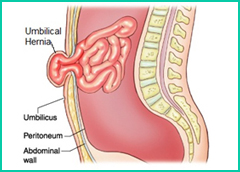Umbilical Hernia
- It is a common type of Hernia and constitutes around 25% of all Hernia cases.
- Umbilical Hernia is often noted at birth as a protrusion at the bellybutton (the umbilicus).
- Umbilical Hernia is caused due to weakened opening in the abdominal wall, which should normally close before birth but fails to close completely.


Causes of umbilical hernia in adults
Umblical hernia that is acquired happens due to intra-abdominal pressure from lifting heavy objects, multiple pregnancies, long history of coughing and obesity.
During pregnancy, the umbilical cord traverses through a little opening or belly button in the baby’s abdominal muscles. This slit normally closes just prior to the birth. If the muscles do not join properly in the middle line of the abdomen, the weakness of the abdominal wall can result in umbilical hernia either at that time or later in life.
Complications of umbilical hernia in adults
Adults who have umbilical hernia are likely to experience intestinal obstruction. In such a case, emergency surgery may be needed. In case of children, the complications are not so common, and they happen only when the abdominal tissue is incarcerated and cannot be retracted into the abdominal cavity. This results in reduced blood supply to the trapped intestine leading to pain in the umbilical area and damage.
Umbilical hernia in adults diagnosis
In the physical exam, the doctor will ask you to do blood tests and imaging studies like an X-ray or abdominal ultrasound may be done to find out complications.
Importantly this type of hernia must be distinguished from a paraumbilical hernia, which occurs in adults and involves a defect in the midline near to the umbilicus, and from omphalocele.
Umblical Hernia in adults Treatment
When the hole is small, say less than 1 or 2 centimeters, it is believed that 90 percent of umbilical hernia cases close in three years. If hernias do not enlarge or are asymptomatic, then there may or may not be a need for surgery.
When is surgery required for umbilical hernia?
In adults, surgery is required as a part of umbilical hernia treatment, epscially if the said hernia becomes bigger or causes pain. During surgery, a little incision is made below the navel. The herniated tissue is pushed back to the abdominal cavity, and the gap in the abdominal wall is stitched. People can go to work within a few hours of surgery and normal activities can be resumed in two to four weeks.
In children,umbilical hernia surgery is needed only if the hernia is large and cause pain. The doctor suggest operation when the hernia gets bigger after the age of 1 or 2 of it is seen to be blocking the intestines.

Post a comment